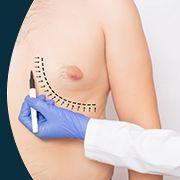Different Types Of Gynecomastia: Diagnosis And Treatment
In This Article
Different Types Of Gynecomastia: Diagnosis And Treatment
Jaymala
Updated on February 06, 2024
Medically verified by Dr. Arya
Fact checked by Dr. Pournami

Cosmetic
5 min read
You already might know what gynecomastia is. If you don’t, it is the enlargement of the breast tissue in males. It is more common than we think.
Did you know that there are different types of gynecomastia? Treatment is according to the type and cause.
There is a lot of data provided everywhere, regarding the condition that you often tend to get confused and start panicking. In most cases, the condition is simple and can be treated easily.
This blog will give you complete knowledge on the condition and its type along with the treatment method for each.
First let’s have a look at the different types of gynecomastia.
Types Of Gynecomastia
-
Idiopathic Gynecomastia: Enlargement without an identifiable cause. The cause is unknown, making diagnosis and treatment challenging.
-
Hereditary Gynecomastia: Gynecomastia with a genetic predisposition. Inherited factors influencing hormone levels and breast tissue sensitivity.
-
Drug-Induced Gynecomastia: Enlargement linked to specific medications. Medications like anabolic steroids, and certain antidepressants.
-
Adult Gynecomastia: Enlargement noticed in adult males. Various reasons, including hormonal imbalances, medications, and any health condition.
-
Adolescent Gynecomastia: Enlargement during puberty. Hormonal fluctuations during adolescence, usually get treated on its own.
-
Bilateral Gynecomastia: Enlargement in both breasts. Typically related to systemic factors such as hormonal imbalances or medication.
-
Unilateral Gynecomastia: Enlargement in only one breast. Associated with factors like tumors or inflammation in one breast.
-
Pseudogynecomastia: Enlarged breasts due to an accumulation of fat. Obesity and excess fat deposition in the chest area.
-
Pathological Gynecomastia: Results from any medical disorder. Conditions such as hypogonadism, tumors, and hormonal imbalances.
-
Physiological Gynecomastia: Occurs as a normal physiological response, especially during infancy, puberty, and aging. Hormonal fluctuations, primarily an imbalance between estrogen and testosterone.
Diagnosis Of Gynecomastia
Here’s how the diagnosis works
-
The type of diagnosis depends upon the symptoms, duration, and any associated pain.
-
Examination of medical history, including medications, drug use, and family history of gynecomastia is necessary.
-
There is assessment of the hormones, liver function test and thyroid disorders.
-
Sometimes ultrasound and mammography are also done. These are done to differentiate between gynecomastia and other breast abnormalities, and to rule out malignancies. In case any malignancy is suspected, a tissue sample may be obtained for pathological examination.
 9 min read
9 min readThe Advantages of Choosing Mykare Health for Gynecomastia Surgery
 6 min read
6 min readIdentifying The Ideal Age For Gynecomastia Surgery
 6 min read
6 min readPre and Post Gynecomastia Surgery: Essential Things to Know
Book Your Consultation Now
Grading Gynecomastia
There are different grades of gynecomastia. We can categorize them as follows:
Grade I: Minimal Enlargement - Small localized breast enlargement without excess skin. It is usually managed with lifestyle modifications and monitoring.
Grade II: Moderate Enlargement - Moderate breast enlargement with mild skin excess. Medical interventions, such as hormone-modulating medications, may be considered.
Grade III: Moderate to Severe Enlargement - Marked breast enlargement with moderate skin excess. It includes a combination of medical treatments and, in some cases, surgery may be recommended.
Grade IV: Severe Enlargement - Significant breast enlargement with excess skin. Surgical intervention, involving mastectomy or liposuction, may be needed.
Causes And Condition
There are many causes and conditions that can lead to gynecomastia. Some of them are given below:
-
An imbalance between estrogen (female hormone) and testosterone (male hormone) levels can lead to breast tissue enlargement.
-
Natural changes in hormonal levels as men age can contribute to gynecomastia.
-
Medications that block the action of male hormones.
-
Certain steroids, used for muscle building can cause hormonal imbalance. Some medications may also have side effects leading to this condition.
Treatment Options
In most cases, adopting a healthy lifestyle with regular exercise, and managing a healthy weight are enough to treat the condition.
In some cases a surgical intervention may be required, where there is excess glandular tissue and skin.
In severe gynecomastia with both glandular and fatty tissue involvement, a combined surgical intervention (liposuction or mastectomy) is needed for good results.
Managing Conditions
Once you come to know the type of your gynecomastia, you can manage the condition by taking care of certain things.
-
Consult with an endocrinologist for hormone level assessment and management.
-
Review and adjust medications under the guidance of a healthcare provider.
-
Explore alternative medications with lower risk of gynecomastia.
-
Manage liver disease and improve liver function. Treatment of the liver condition.
-
Check for any renal disorder. Nephrology consultation, or dialysis, may be needed.
Psychological Impact And Counseling
Gynecomastia can lead you to anxiety, depression, and a negative impact on self-esteem and body image.
You can suffer from social withdrawal, avoidance of some activities, and less confidence.
Body image issues are another thing that you might have. This includes obsessive focus on chest appearance, reluctance to expose the chest in public, and avoiding activities like swimming which needs body exposing.
Gynecomastia can affect daily functioning, relationships, and overall well-being. Teasing by peers could later lead to psychological disorders.
Counseling provides emotional support, coping strategies, and a safe space for you to express your feelings.
Individual or group counseling sessions may be required, to address the psychological influence of gynecomastia.
It is necessary to provide accurate information about gynecomastia, its causes, and available treatments to alleviate concerns. Educate individuals about the condition and reassure them that it is a common and treatable condition.
Preventive Measures
You can also take some preventive measures as follows:
-
Acknowledge the emotional and psychological influence of gynecomastia on individuals. Understand that gynecomastia may lead to body image issues, self-esteem challenges, and social anxiety.
-
Encourage individuals to seek the support of mental health professionals. Provide counseling sessions tailored to address the emotional aspects of gynecomastia.
-
Connect individuals with support groups or online communities where they can share experiences and coping strategies.
-
Encourage open communication between healthcare providers and individuals with gynecomastia. Involve family members in discussions to create a supportive environment.
Advancement In Gynecomastia Treatment
Encourage a healthy and balanced diet with regular exercise.
Follow regular health check-ups to monitor hormonal levels.
Include adequate sleep and follow stress management.
Gynecomastia is the enlargement of breast tissue in males.
It can be classified into physiological, pathological, and pseudogynecomastia
Treatment includes watchful waiting, lifestyle changes, medications, surgical intervention, monitoring the condition, and psychological support.
Management involves checking hormonal imbalances, adjusting medications, treating liver or kidney disease, and lifestyle modifications.
Gynecomastia can have significant psychological effects, and counseling services are essential to boost self esteem and confidence.
Preventive measures include maintaining a healthy lifestyle and maintaining healthy weight.
Advances in gynecomastia treatment include, non-surgical options, scarless mastectomy, regenerative medicine, patient-specific treatment plans, hormonal therapies, genetic studies, and psychological support.
Treatment decisions are different, considering the severity of gynecomastia. Regular follow-up appointments are important.



